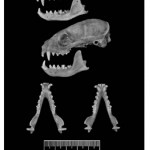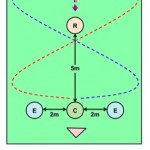Life Sciences
I dread packing and flying, but on the planner for August is the 2010 APS Intersociety Meeting: Global Change and Global Science: Comparative Physiology in a Changing World http://the-aps.org/meetings/aps/comparative/index.htm. A must-do meeting for me.
The theme of the meeting is how comparative and evolutionary animal physiologists can contribute to understanding the consequences of global change and how understanding global change requires broad, global science. Seems as if this is the first conference of any type to focus mainly on the effects of global climate change on animal…
Welcome to the 26th edition of the Carnival of Evolution!
To begin, consider the adaptive rhymes of evolution from the Digital Cuttlefish.
There was a LOT of evolutionary blogging this month, so let's just jump right in to the rest, shall we?
Let's start with animals (This is the Thoughtful Animal blog, after all.)
Zen Faulkes at Neurodojo starts us out with a sweet tale of a lizard in a life-boat. He asks, "How old would you expect the Bermuda skink lineage to be? 'Well, the island's only two million years old, so it's got to be younger than that.' " The answer may surprise you. And,…
A new mammal species has been discovered in Madagascar, and is described here on Tetrapod Zoology. It is NOT a primate.
Brian Switek reviews Shooting in the Wild: An Insider's Account of Making Movies in the Animal Kingdom, an important book that "an in-depth look at wild animals on film, covering the history of wildlife documentaries, safety issues, and the never-ending pressure to obtain the "money shot."" (booklist). Brian's review, which I highly recommend, is HERE.
The PLoS Blog Pick of the Month for July has been announced, and it's a post by Hannah Waters of Culturing Science on…
T. Ryan Gregory asks this important question: Who is a scientist? It's a followup to a post titled: "Graduate students are not professional scientists. Discuss," which â briefly â argued that grad students are scientists in training, not yet scientists-full-stop. In the later post, he explains:
Here are the criteria I threw out off-handedly for the purpose of discussing the NYT story about science blogs [this one -Josh]:
- Does scientific research for a living,
- Publishes research in peer-reviewed journals,
- Is funded by granting agencies to do it,
- Does not just write about it, or…
The fact that new, modern-day mammal species are discovered on a fairly regular basis should most definitely not be a surprise to the average Tet Zoo reader. These are not all 'cryptic species' distinguishable only on the basis of DNA: many are morphologically distinctive, honest-to-goodness new animals discovered either in the field or in museum collections. And they're not all bats and rodents: new monkeys, lemurs, sloths and hoofed mammals (peccaries, deer and bovids) have been named in recent years.
Mention 'new mammals' and 'Madagascar', and most people will assume that you're talking…
Well, this was a weird article in Nature that made me think, at least: A world without mosquitoes. I was surprised to learn that there are actually ecologists/entomologists who believe the world would be a better place if we could simply exterminate entire genera of winged pests — that mosquitoes fill a readily replaceable niche, that they make minimal positive contributions to ecosystems, and we'd gain immeasurably from removing animals responsible for so much human suffering. The one thing they also agree on, though, is that there is no way to do it.
And so, while humans inadvertently drive…
Dave Pollard's latest at Salon is an interesting cry in the dark about how hard it is to connect with others when you see collapse coming. My guess is that some of my readers will respond with a great deal of identification, while others will be annoyed by Pollard - but I think it bears some considering.
For me, what's interesting about this is the most basic and ordinary social challenge - because this is a painful, hard and ugly place to do the most important work of adaptation from - building community. But in observing that it is painful, hard and ugly, I do not mean to imply it is…
In general, the ability to attribute attention to others seems important: it allows an animal to notice the presence of other individuals (whether conspecifics, prey, or predators) as well as important locations or events by following the body orientation or eyegaze of others. We've spent a lot of time here at The Thoughtful Animal thinking about how domestication has allowed dogs to occupy a unique niche in the social lives of humans. They readily understand human communication cues such as eye-gaze and finger-pointing, and capitalize on the infant-caregiver attachment system to have their…
I'm one of those dreadful animal-centric zoologically inclined biologists. Plants? What are those? Fungi? They're related to metazoans somehow. Lichens? Not even on the radar. The first step in fixing a problem, though, is recognizing that you have one. So I confess to you, O Readers, that my name is PZ, and I am a metazoaphile. But I can get better.
My path to opening up to wider horizons is to focus on what I find most interesting about animals, and that is that they are networks of cells driven by networks of genes that generate patterned responses of expression by cell signaling, or…
I said in the previous pronghorn article that the modern pronghorn - Antilocapra americana - is but the tip of the phylogenetic iceberg, if you will; the only surviving member of a group that was previously far more diverse [the adjacent photo (from wikipedia) shows Ramoceros osborni. Yes, it really looked like that, read on].
As we'll see here, fossil pronghorns encompassed a reasonable amount of diversity: there were kinds with deer-like pseudo-antlers as well as others that superficially resembled living African antelopes like kudu or nyala, there were tiny dwarf forms, and there were…
The Pronghorn or Pronghorn antelope* Antilocapra americana is a strikingly unique artiodactyl, endemic to western North America. Historically, it ranged from southern Manitoba and Washington in the north to northern Mexico in the south, and to western Iowa in the east. Between 40 and 50 million Pronghorns were alive in 1850; excessive hunting had reduced this number to 13000 by 1920. Subsequent conservation efforts have resulted in substantial recovery: there are currently between half a million and one million Pronghorns.
* Also known as the Cabrit, Prong Buck, Speedgoat (my favourite) or…
I've got a new article in the latest Wired on the science of stress, as seen through the prism of Robert Sapolsky. The article isn't online yet (read it on the iPad!), but here are the opening paragraphs:
Baboons are nasty, brutish and short. They have a long muzzle and sharp fangs designed to inflict deadly injury. Their bodies are covered in thick, olive-colored fur, except on their buttocks, which are hairless. The species is defined by its social habits: The primates live in troops, or small groupings of several dozen individuals. These troops have a strict hierarchy, and each animal is…
The list is growing fast - check the submissions to date and get inspired to submit something of your own - an essay, a poem, a cartoon or original art.
The Submission form is here so you can get started. Under the fold are entries so far, as well as buttons and the bookmarklet. The instructions for submitting are here.
You can buy the last four annual collections here. You can read Prefaces and Introductions to older editions here.
============================
A Blog Around The Clock: What does it mean that a nation is 'Unscientific'?
A Blog Around The Clock: My latest scientific paper:…
tags: Birdbooker Report, bird books, animal books, natural history books, ecology books
Books to the ceiling,
Books to the sky,
My pile of books is a mile high.
How I love them! How I need them!
I'll have a long beard by the time I read them.
~ Arnold Lobel [1933-1987] author of many popular children's books.
The Birdbooker Report is a special weekly report of a wide variety of science, nature, environment and behavior books and field guides that currently are, or soon will be available for purchase. This report is written by one of my Seattle birding pals and book collector, Ian "…
I just received my copies of Dinosaurs Life Size, a children's book published by Barron's Educational in the USA and by New Burlington Books in the UK (Naish 2010). You can get it from amazon here (here from amazon.co.uk). You might wonder why I'm advertising a children's book when I could be publishing articles on gekkotans, amebelodontid proboscideans or solitaire hands (all of which are due to appear here very soon). Well, hey, it's my blog right?
Dinosaurs Life Size is large-format and includes spreads on a diversity of dinosaurs as well as pterosaurs and Mesozoic marine reptiles. Some…
Sometimes, I really hate fossils. I hate them with the passion of a spurned lover, one who is consumed with desire but knows that he will never, ever be satisfied. They drive me mad.
Right now we're at a point in our technology where we can take a small sample from a living organism and break it down into amazing detail — we can extract every gene, throw them into a computer, and compare them with every other gene that has been similarly sampled. We can look for the scars of evolution, we can analyze and figure out where on the tree of life this cell resides, we can even figure out what…
There are 29 new articles in PLoS ONE today. As always, you should rate the articles, post notes and comments and send trackbacks when you blog about the papers. You can now also easily place articles on various social services (CiteULike, Mendeley, Connotea, Stumbleupon, Facebook and Digg) with just one click. Here are my own picks for the week - you go and look for your own favourites:
Chimpanzees Extract Social Information from Agonistic Screams:
Chimpanzee (Pan troglodytes) agonistic screams are graded vocal signals that are produced in a context-specific manner. Screams given by…
There are many new articles in four PLoS journals today. As always, you should rate the articles, post notes and comments and send trackbacks when you blog about the papers. You can now also easily place articles on various social services (CiteULike, Mendeley, Connotea, Stumbleupon, Facebook and Digg) with just one click. Here are my own picks for the week - you go and look for your own favourites:
Barcoding Life to Conserve Biological Diversity: Beyond the Taxonomic Imperative:
In the 250 years since the Swedish scientist Carl Linnaeus first started classifying organisms, taxonomists have…
The list is growing fast - check the submissions to date and get inspired to submit something of your own - an essay, a poem, a cartoon or original art.
The Submission form is here so you can get started. Under the fold are entries so far, as well as buttons and the bookmarklet. The instructions for submitting are here.
You can buy the last four annual collections here. You can read Prefaces and Introductions to older editions here.
============================
A Blog Around The Clock: What does it mean that a nation is 'Unscientific'?
A Blog Around The Clock: My latest scientific paper:…
tags: Birdbooker Report, bird books, animal books, natural history books, ecology books
Books to the ceiling,
Books to the sky,
My pile of books is a mile high.
How I love them! How I need them!
I'll have a long beard by the time I read them.
~ Arnold Lobel [1933-1987] author of many popular children's books.
The Birdbooker Report is a special weekly report of a wide variety of science, nature, environment and behavior books and field guides that currently are, or soon will be available for purchase. This report is written by one of my Seattle birding pals and book collector, Ian "…






